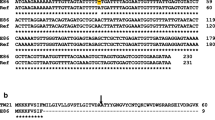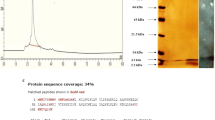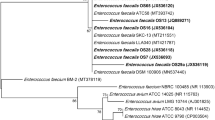Abstract
The bacteriocin susceptibility of Listeria monocytogenes MTCC 657, Enterococcus faecium DSMZ 20477, E. faecium VRE, and E. faecalis ATCC 29212 and their corresponding bacteriocin resistant variants was assessed. The single and combined effect of nisin and pediocin 34 and enterocin FH99 bacteriocins produced by Pediococcus pentosaceus 34, and E. faecium FH99, respectively, was determined. Pediocin34 proved to be more effective in inhibiting L. monocytogenes MTCC 657. A greater antibacterial effect was observed against E. faecium DSMZ 20477 and E. faecium (VRE) when the a combination of nisin, pediocin 34 and enterocin FH99 were used whereas in case of L. monocytogenes MTCC 657 a combination of pediocin 34 and enterocin FH99 was more effective in reducing the survival of pathogen. Bacteriocin cross-resistance and the antibiotic susceptibility of wild type and their corresponding resistant variants were assessed and results showed that resistance to a bacteriocin may extend to other bacteriocins within the same class and also the acquired resistance to bacteriocins can modify the antibiotic susceptibility/resistance profile of the bacterial species used in the study. According to the hydrophobicity nisin resistant variant of L. monocytogenes was more hydrophobic (p < 0.001), whereas the pediocin 34 and enterocin FH99 resistant variants were less hydrophobic than the wild type strain. Nisin, pediocin 34 and enterocin FH99 resistant variants of E. faecium DSMZ 20477 and E. faecium VRE were less hydrophobic than their wild type counterparts. Nisin resistant E. faecalis ATCC 29212 was less hydrophobic than its wild type counterpart.

Similar content being viewed by others
References
Banerjee SP, Dora KC, Chowdhury S (2011) Detection, partial purification and characterization of bacteriocin produced by Lactobacillus brevis FPTLB3 isolated from freshwater fish Bacteriocin from Lb. brevis FPTLB3. J Food Sci Technol. doi:10.1007/s13197-011-0240-4
Bankerroum N, Sandine WE (1988) Inhibitory action of nisin against Listeria monocytogenes. J Dairy Sci 71:3237–3245
Barefoot SF, Klaenhammer TR (1983) Detection and activity of Lactacin B, a bacteriocin produced by Lactobacillus acidophilus. Appl Environ Microbiol 45:1808–1815
Biswas SR, Ray P, Johnson MC, Ray B (1991) Influence of growth conditions on the production of a bacteriocin AcH by Pediococcus acidilactici H. Appl Environ Microbiol 5:1265–1267
Cintas LM, Casaus P, Fernandez MF, Hernández PE (1998) Comparative antimicrobial activity of enterocin L50, pediocin PA-1, nisin A, and lactocin S against spoilage and foodborne pathogenic bacteria. Food Microbiol 15:289–298
Crandall AD, Montville TJ (1998) Nisin resistance in Listeria monocytogenes ATCC 700302 is a complex phenotype. Appl Environ Microbiol 64(231):237
Davies EA, Falahee MB, Adams MR (1996) Involvement of the cell envelope of Listeria monocytogenes in the acquisition of nisin resistance. J Appl Bacteriol 81:139–146
De Man JC, Rogosa M, Sharpe ME (1960) A medium for the cultivation of lactobacilli. J Appl Bacteriol 2:130–135
Dykes GA, Hastings JW (1998) Fitness costs associated with class IIa bacteriocin resistance in Listeria monocytogenes B73. Lett Appl Microbiol 26:5–8
Foulique Moreno MR, Sarantinopoulos P, Tsakalidou E, De Vuyst L (2006) The role and application of enterococci in food and health. Intl J Food Microbiol 106:1–24
Franz CMAP, Schillinger U, Holzapfel WH (1996) Production and characterization of enterocin 900, a bacteriocin produced by Enterococcus faecium BFE 900 from black olives. Intl J Food Microbiol 29:255–270
Galvez A, Valdivia E, Abriouel H, Camafeita E, Mendez E, Martinez-Bueno M, Maqueda M (1998) Isolation and characterization of enterocin EJ97, a bacteriocin produced by Enterococcus faecalis EJ97. Arch Microbiol 171:59–65
Galvez A, López RL, Abriouel H (2008) Application of bacteriocins in the control of foodborne pathogenic and spoilage bacteria. Crit Rev Biotech 28:125–152
Giraffa G (1995) Enterococcal bacteriocins: their potential as anti- Listeria factors in dairy technology. Food Microbiol 12:291–299
Gravesen A, Sorensen K, Aarestrup FM, Knochel S (2001) Spontaneous nisin resistant Listeria monocytogenes mutants with increased expression of a putative penicillin-binding protein and their sensitivity to various antibiotics. Microb Drug Resis 7:127–135
Gupta H, Malik RK, De S, Kaushik JK (2010) Purification and Characterization of Enterocin FH 99 Produced by a Faecal Isolate Enterococcus faecium FH 99. Indian J Microbiol 50:145–155
Hanlin MB, Kalchayanand N, Ray P, Ray B (1993) Bacteriocins of lactic acid bacteria in combination have greater antibacterial activity. J Food Protect 56:252–255
Harris LJ, Fleming HP, Klaenhammer TR (1991) Sensitivity and resistance of Listeria monocytogenes ATCC 19115, Scott A and UAL500 to nisin. J Food Prot 54:836–840
Jamuna M, Jeevaratnam K (2009) Antibacterial efficacy of nisin and pediocins against food spoilage and pathogenic organisms in broth and a vegetarian food. J Food Sci Technol 46(6):563–568
Jamuna M, Babusha ST, Jeevaratnam K (2005) Inhibitory efficacy of nisin and bacteriocins from Lactobacillus isolates againast food spoilage and pathogenic organisms in model and food systems. Food Microbiol 22:449–454
Kaur G, Malik RK, Mishra SK, Singh TP, Bharadwaj A, Singroha G, Vij S, Kumar N (2010) Nisin and class IIa bacteriocin resistance among listeria and other food-borne pathogens and spoilage bacteria. Microb Drug Resis 17(2):197–205
Limonet M, Revol-Junelles A, Cailliez-Grimal C, Milliere J (2004) Synergistic mode of action of mesenterocins 52A and 52B produced by Leuconstoc mesenteroides subsp. mesenteroides FR 52. Curr Microbiol 48:204–207
Martinez B, Rodriguez A (2005) Antimicrobial susceptibility of nisin resistant Listeria monocytogenes of dairy origin. FEMS Microbiol Lett 252:67–72
Mazzotta AS, Montville TJ (1997) Nisin induces changes in membrane fatty acid composition of Listeria monocytogenes nisin-resistant strains at 10 °C and 30 °C. J Appl Microbiol 82:32–38
Moll GN, Konings WN, Driessen AJM (1999) Bacteriocins: mechanism of membrane insertion and pore formation. Anton Leeuwen 76:185–198
Mullet-Powell N, Lacoste-Armynot AM, Viñas M, Simeon de Buochberg M (1998) Interactions between pairs of bacteriocins from lactic acid bacteria. J Food Prot 61:1210–1212
Muriana PM (1996) Bacteriocins for control of Listeria spp. in food. J Food Prot (Suppl). 54–63
National Committee for Clinical Laboratory Standards (2001) Performance standards for antimicrobial susceptibility testing; eleventh international supplement. NCCLS document M100–S11. National Committee for Clinical Laboratory Standards. Wayne, Pa.
Nunez M, Rodrıguez JL, Garcıa E, Gaya P, Medina M (1997) Inhibition of Listeria monocytogenes by enterocin 4 during the manufacture and ripening of Manchego cheese. J Appl Microbiol 83:671–677
Peschel A, Ott M, Jack RW, Kalbacher H, Jung G, Gotz F (1999) Inactivation of the dlt operon in Staphylococcus aureus confers sensitivity to defensins, protegrins, and other antimicrobial peptides. J Biol Chem 274:8405–8410
Rao KN, Malik, RK (2003) Emerging biotechnologies in dairy and meat processing Chromosomal linked bacteriocin production in Pediococcus pentosaceus. In: Marwaha SS, Arora JK (eds.) Biotechnological Strategies in Agroprocessing. Asiatech Publications, New Delhi, pp. 230–257
Rekhif N, Atrih A, Lefebvre G (1994) Selection and properties of spontaneous mutants of Listeria monocytogenes ATCC 15313 resistant to different bacteriocins produced by lactic acid bacteria strains. Curr Microbiol 28:237–241
Rosenberg M, Gutnick D, Rosenberg E (1980) Adherence of bacteria to hydrocarbons: a simple method for measuring cell-surface hydrophobicity. FEMS Microbiol Lett 9:29–33
Sarantinopoulos P, Leroy F, Leontopoulou E, Georgalaki MD, Kalantzopoulos G, Tsakalidou E, De Vuyst L (2002) Bacteriocin production by Enterococcus faecium FAIR-E 198 in view of its application as adjunct starter in Greek feta cheese making. Intl J Food Microbiol 72:125–136
Schillinger U, Chung HS, Keppler K, Holzapfel WH (1998) Use of bacteriocinogenic lactic acid bacteria to inhibit spontaneous nisin-resistant mutants of Listeria monocytogenes Scott A. J Appl Microbiol 85:657–663
Song HJ, Richard J (1997) Antilisterial activity of three bacteriocins used at sub-minimal inhibitory concentrations and cross-resistance of the survivors. Int J Food Microbiol 36:155–161
Torri Tarelli G, Carminati D, Giraffa G (1994) Production of bacteriocins active against Listeria monocytogenes and Listeria innocua from dairy enterococci. Food Microbiol 11:243–252
Ukuku DO, Shelef LA (1997) Sensitivity of six strains of L. monocytogenes to nisin. J Food Prot 60:867–869
Ulhman U, Schillinger U, Rupnow JR, Holzapfel WH (1992) Identification and characterization of two bacteriocin-producing strains of Lactococcus lactis isolated from vegetables. Int J Food Microbiol 16:141–151
Vignolo G, Palacios J, Farias ME, Sesma F, Schillinger U, Holzapfel W, Oliver G (2000) Combined effect of bacteriocins on the survival of various Listeria species in broth and meat system. Curr Microbiol 41:410–416
Author information
Authors and Affiliations
Corresponding author
Rights and permissions
About this article
Cite this article
Kaur, G., Singh, T.P., Malik, R.K. et al. Antibacterial efficacy of nisin, pediocin 34 and enterocin FH99 against L. monocytogenes, E. faecium and E. faecalis and bacteriocin cross resistance and antibiotic susceptibility of their bacteriocin resistant variants. J Food Sci Technol 51, 233–244 (2014). https://doi.org/10.1007/s13197-011-0500-3
Revised:
Accepted:
Published:
Issue Date:
DOI: https://doi.org/10.1007/s13197-011-0500-3




